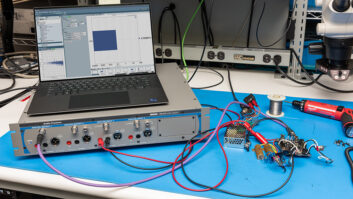In nearly every sector of professional audio — recording,broadcast, post-production, contracting or sound reinforcement— the benefits of networking and the convenience ofsharing/accessing audio files among many users within a facilityare obvious. Unfortunately, setting up an audio network can be adaunting task of interconnecting routers, hubs, networking cards,computers and other peripherals. With that in mind, Otari hasintroduced a simple audio networking solution based on its ND-20, amodular unit that communicates to other ND-20s via an IEEE 1394(FireWire) derivative called mLAN, where audio signals can bedistributed throughout a high-speed network and output in analog ordigital signal formats.
Housed in a two-rackspace chassis, each ND-20 offers up to32-channel capability (or 16 channels at 96 kHz) and has four rearpanel slots for I/O modules. Available 8-channel modules include+4dB analog line inputs, +4dB analog line outputs, XLR mic inputsand multichannel AES/EBU digital.
The optional CB-178 remote control unit is a compact tabletop(or console-top) unit that adds real-time control ofgain/pad/limiting/phantom power for any mic preamp module in thenetwork, as well as offering remote system configuration. TheCB-178 communicates via FireWire and adds the ability to select andmonitor any channel with a 20-segment LED level meter and headphoneoutput with level control. The system can be controlled frommultiple points by using two or more CB-178s.
The ND-20 can also be used as a stand-alone AD/DA converter with24-bit resolution. All I/Os are capable of 96, 48, 44.1 and 32kHzsample rates (with ± 12% varipitch), plus pull-up/pull-downrates. MADI and TDIF I/O, as well as mLAN (over the IEEE 1394high-speed serial bus) formats are also available. Sample rateconversion is built into all AES input channels with individualcontrol over each channel.
Other ND-20 features include selectable internal or externalclocking (with BNC wordclock I/O provided for the latter) and rearpanel switches for routing the signals from each I/O and settingsystem configurations. The ND-20 can be AC- or DC-powered, and bothpower inputs can be used simultaneously in broadcast-styleinstallations requiring redundant power supplies for fail-safeoperation in the case of blackouts or other AC loss.
Multiple ND-20s can be connected using standard 6-pin IEEE 1394cable or fiber optics to create an audio network capable of 96channels (48-, 44.1 kHz) or 64 channels at 96 kHz. Using the 3-portIEEE 1394 interface on the ND-20’s rear panel, various networktopologies can be created either in a simple“daisychain” arrangement (attaching 16 additionalND-20s in series) or a “multiple-chain” array, whichuses several ND-20s in series, each feeding more ND-20s in atree-style configuration. More complex possibilities are possibleby adding a third-party IEEE 1394 hub to create “star”networks.
Because the configuration is IEEE 1394-based, individual unitscan be hot-swapped without the need to power-down the rest of thenetwork. Likewise, ND-20 networks are subject to the limitations ofother IEEE 1394 protocols; for example, a maximum of 63 devices canbe connected to a single network, and no more than 16 cables can beused between the most distant devices. Using a wired connection,the maximum distance between two adjacent units is 4.5 meters,although the use of an optical cable extends this distance to 500meters. Another point to keep in mind is that the ND-20 currentlysupports a 200MB/second bandwidth. ND-20 support of 400MB/second— via an optional plug-in daughterboard — is plannedfor later this year, which would increase the maximum number ofsystem channels to 192, depending on the connections and/or samplerate requirements.
The ND-20 is priced from $3,895 — additional I/O modulesbegin at $730. A wide variety of options (including the $1,895CB-178 remote) are offered, so systems can be tailored to suitindividual needs.
Otari Corporation, 8236 Remmet Ave. Canoga Park, CA 91304;818/598-1256; fax 818/594-7208; www.otari.com.







